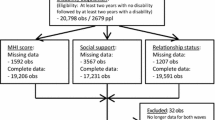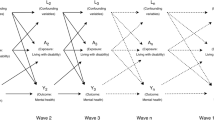Abstract
Background
Young people with disabilities have poorer mental health than their non-disabled peers. However, people with disabilities are more likely than others to experience financial hardship and low social support, both of which have been linked with poor mental health outcomes. This article explores the extent to which the relatively poor mental health of young people with disabilities is related to the social conditions in which they live.
Methods
Secondary analysis was performed on Wave 6 (2006) of the survey of Household Income and Labour Dynamics in Australia (HILDA). This nationally representative sample included 3,392 young Australians, aged 15–29, of whom 475 reported having a long-term health condition, impairment or disability.
Results
Young people with disabilities reported poorer mental health than their non-disabled peers. However, this relationship was moderated by both social adversity and social support, with minimal differences in mental health observed between the groups under conditions of high social support and low financial hardship.
Discussion
The results suggest that disability represents a potential adversity that may be exacerbated or ameliorated by the effects of wealth/financial hardship and social support.
Conclusion
It may be possible to improve the mental health of disabled people by addressing their social exclusion.




Similar content being viewed by others
References
Australian Bureau of Statistics (1997) SF-36 population norms: Australia. ABS, Canberra
Australian Bureau of Statistics (1998) Mental health and wellbeing: profile of adults, Australia, 1997. ABS, Canberra
Australian Bureau of Statistics (2003) Information paper: disability, ageing and carers, Australia: user guide 2003. ABS, Canberra
Australian Bureau of Statistics (2005) Australian social trends 2005. ABS, Canberra
Australian Bureau of Statistics (2007) 20680-indigenous status by age—Australia. ABS, Canberra
Australian Bureau of Statistics (2007) Basic community profile 2006 census community profile series. ABS, Canberra
Australian Bureau of Statistics (2008) Australian social trends 2008: population distribution. ABS, Canberra
Australian Institute of Health, Welfare (2003) Disability prevalence and trends. AIHW, Canberra
Australian Institute of Health, Welfare (2007) Young Australians: their health and wellbeing 2007. AIHW, Canberra
Australian Institute of Health, Welfare (2008) Disability in Australia: trends in prevalence education employment and community living. AIHW, Canberra
Bajekal M, Harries T, Breman R, Woodfield K (2004) Review of disability estimates and definitions. National Centre for Social Research, London
Bethune-Davies P, McWilliam C, Bermen H (2006) Living with the health and social inequities of a disability: a critical feminist study. Health Care Women Int 27:204–222
Burchardt T, Le Grand J, Piachaud D (2002) Degrees of exclusion: developing a dynamic, multidimensional measure. In: Hills J, Le Grand J, Piachaud D (eds) Understanding social exclusion. Oxford University Press, Oxford, pp 30–43
Butterworth P, Crosier T (2004) The validity of the SF-36 in an Australian national household survey: demonstrating the applicability of the Household Income and Labour Dynamics in Australia (HILDA) Survey to examination of health inequalities. BMC Public Health, pp 1–11
Cepeda ML, Allen FH, Cepeda NJ, Yang Y-M (2000) Physical growth, sexual maturation, body image and sickle cell disease. J Natl Med Assoc 92:10–14
Claussen B (1999) Alcohol disorders and re-employment in a 5-year follow-up of long-term unemployed. Addiction 94:133–138
Committee on Children with Disabilities and Committee on Psychosocial Aspects of Child and Family Health (1993) Psychosocial risks of chronic health conditions in childhood and adolescence. Pediatrics 92:876–877
Connell RW (1995) Masculinities. Allen and Unwin, Sydney
Crosier T, Butterworth P, Rodgers B (2007) Mental health problems among single and partnered mothers: the role of financial hardship and social support. Social Psychiatry Psychiatr Epidemiol 42:6–13
Einfeld SL, Piccinin AM, Mackinnon A et al (2006) Psychopathology in young people with intellectual disability. JAMA 296:1981–1989
Emerson E, Hatton C (2007) The contribution of socio-economic position to the health inequalities faced by children and adolescents with intellectual disabilities in Britain. Am J Ment Retard 112:140–150
Emerson E, Hatton C (2007) Mental health of children and adolescents with intellectual disabilities in Britain. Br J Psychiatry 191:493–499
Emerson E, Honey A, Madden R, Llewellyn G (2009) The well-being of Australian adolescents and young adults with self-reported long-term health conditions, impairments or disabilities: 2001 and 2006. Aust J Soc Issues 44:39–53
Fagg J, Curtis S, Stansfeld SA, Congdon P (2006) Psychological distress among adolescents, and its relationship to individual, family and area characteristics in East London. Soc Sci Med 63:636–648
Fone D, Dunstan F, Williams G, Lloyd K, Palmer S (2007) Places, people and mental health: a multilevel analysis of economic inactivity. Soc Sci Med 64:633–645
Fuhrer R, Stansfeld SA, Chemali J, Shipley MJ (1999) Gender, social relations and mental health: prospective findings from an occupational cohort (Whitehall II study). Soc Sci Med 48:77–87
Gallo LC, Matthews KA (2003) Understanding the association between socioeconomic status and physical health: do negative emotions play a role? Psychol Bull 129:10–51
Gannon B, Nolan B (2006) The dynamics of disability and social inclusion in Ireland. The Economic and Social Research Institute, Dublin
Gannon B, Nolan B (2007) The impact of disability transitions on social inclusion. Soc Sci Med 64:1425–1437
Goggin G, Newell C (2005) Disability in Australia: exposing a social apartheid. UNSW Press, Sydney
Gortmaker SL, Perrin JM, Weitzman M, Homer CJ, Sobol AM (1993) An unexpected success story: transition to adulthood in youth with chronic physical health conditions. J Res Adolesc 3:317–336
Gray KM, Mohr C (2004) Mental health problems in children and adolescents with intellectual disability. Curr Opin Psychiatry 17:365–370
Headey B, Warren D (2008) Families, incomes and jobs, volume 3: a statistical report on waves 1 to 5 of the HILDA survey. Melbourne Institute of Applied Economic and Social Research, Melbourne
Henderson S, Duncan-Jones P, McAuley H, Ritchie K (1978) The patient’s primary group. Br J Psychiatry 132:74–86
HILDA (2006) HILDA survey annual report 2006. Melbourne Institute of Applied Economic and Social Research, University of Melbourne, Melbourne
Jenkins S, Rigg J (2004) Disability and disadvantage: selection, onset and duration effects. J Soc Policy 33:479–501
Kerr DC, Preuss LJ, King CA (2006) Suicidal adolescents’ social support from family and peers: gender-specific associations with psychopathology. J Abnorm Child Psychol 34:103–114
Klineberg E, Clark C, Bhui KS, Haines MM, Viner RM, Head J et al (2006) Social support, ethnicity and mental health in adolescents. Soc Psychiatry Psychiatr Epidemiol 41:755–760
Kolaitis G (2008) Young people with intellectual disabilities and mental health needs. Curr Opin Psychiatry 21:469–473
Kuh D, Power C, Blane D, Bartley M (2004) Socioeconomic pathways between childhood and adult health. In: Kuh D, Ben-Shlomo Y (eds) A life course approach to chronic disease epidemiology. Oxford University Press, Oxford, pp 371–398
Luthar SS (2003) Resilience and vulnerability: adaptation in the context of childhood adversities. Cambridge University Press, Cambridge
Marmot M, Wilkinson RG (eds) (2006) Social determinants of health, 2nd edn. Oxford University Press, Oxford
Marshall ML, Barnett RC (1993) Work family strains and gains among two-earner couples. J Community Psychol 21:64–78
McClish D, Penberthy L, Bovbjerg V, Roberts J, Aisiku I, Levenson J, Roseff S, Smith W (2005) Health related quality of life in sickle cell patients: the PiSCES project. Health Qual Life Outcomes 3:50
Miauton L, Narring F, Michaud PA (2003) Chronic illness, life style and emotional health in adolescence: results of a cross-sectional survey on the health of 15–20-year-olds in Switzerland. Eur J Pediatr 162:682–689
Mont D (2007) Measuring disability prevalence. Social protection discussion papers. World Bank, Washington
Morrell S, Taylor R, Quine S, Kerr C, Western J (1994) A cohort study of unemployment as a cause of psychological disturbance in Australian youth. Soc Sci Med 38:1553–1564
Neumark-Sztainer D, Story M, Resnick MD, Garwick A, Blum RW (1995) Body dissatisfaction and unhealthy weight-control practices among adolescents with and without chronic illness: a population-based study. Arch Pediatr Adolesc Med 149:1330–1335
Patterson J, Blum RW (1996) Risk and resilience among children and youth with disabilities. Arch Pediatr Adolesc Med 150:692–698
Perrin JM (2002) Health services research for children with disabilities. Milbank Q 80:303–324
Perry MJ (1996) The relationship between social class and mental disorder. J Prim Prev 17:17–30
Pickett KE, Wilkinson RG (2007) Child wellbeing and income inequality in rich societies: ecological cross sectional study. BMJ 335:1080–1086
Sanson-Fisher RW, Perkins JJ (1998) Adaptation and validation of the SF-36 Health Survey for use in Australia. J Clin Epidemiol 51:961–967
Saunders P (2006) The costs of disability and the incidence of poverty. Social Policy Research Centre, University of NSW, Sydney
Sawyer MG, Arney FM, Baghurst PA, Clark JJ, Graetz BW, Kosky RJ, Nurcombe B, Patton GC, Prior MR, Raphael B, Rey J, Whaites LC, Zubrick SR (2000) Mental health of young people in Australia: child and adolescent component of the National Survey of Mental Health and Well-being. Commonwealth Department of Health and Aged Care, Canberra
Sawyer SM, Drew S, Yeo MS, Britto MT (2007) Adolescents with a chronic condition: challenges living, challenges treating. Lancet 369:1481–1489
Seigel W, Golden N, Gough J, Lashley M, Sacker I (1990) Depression, self-esteem, and life events in adolescents with chronic illness. J Adolesc Health Care 11:501–504
Smith DM, Langa KM, Kabeto MU, Ubel PA (2005) Health, wealth, and happiness: financial resources buffer subjective well-being after the onset of a disability. Psychol Sci 16:663–666
Stam H, Hartman EE, Deurloo JA, Groothoff J, Grootenhuis MA (2006) Young adult patients with a history of pediatric disease: impact on course of life and transition into adulthood. J Adolesc Health 39:4–13
Stewart D, Antle BJ, Healy H, Law M, Young NL (2007) Best practice guidelines for transition to adulthood for youth with disabilities in Ontario: an evidence-based approach. CanChild Centre for Childhood Disability Research, Ontario
Varni J, Limbers C, Burwinkle T (2007) Impaired health-related quality of life in children and adolescents with chronic conditions: a comparative analysis of 10 disease clusters and 33 disease categories/severities utilizing the PedsQL™ 4.0 Generic Core Scales. Health Qual Life Outcomes 5:43
Ware JE, Sherbourne CD (1992) The MOS 36-item short-form health survey (SF-36) I. Conceptual framework and item selection. Med Care 30:473–483
Ware JE, Snow KK, Kosinski M, Gandek B (2000) SF-36 Health Survey: manual and interpretation guide. QualityMetric Inc., Lincoln
Watson N (ed) (2008) HILDA user manual: Release 6. Melbourne Institute of Applied Economic and Social Research, University of Melbourne, Melbourne
Watson N, Wooden M (2002) The Household, Income and Labour Dynamics in Australia (HILDA) survey: wave 1 survey methodology. HILDA project technical paper series. University of Melbourne, Melbourne
Wight RG, Botticello AL, Aneshensel CS (2006) Socioeconomic context, social support, and adolescent mental health: a multilevel investigation. J Youth Adolesc 35:115–126
Wilkinson RG (2005) The impact of inequality. The New Press, New York
Wolman C, Resnick MD, Harris LJ, Blum RW (1994) Emotional well-being among adolescents with and without chronic conditions. J Adolesc Health 15:199–204
World Health Organisation (2008) Closing the gap in a generation: health equity through action on the social determinants of health. Final report of the Commission on Social Determinants of Health. World Health Organization, Geneva
Acknowledgments
This research was the outcome of the collaboration “Achieving Better Health Outcomes for Youth with Chronic Health Conditions: A Pan Disciplinary Approach”. The collaboration was seed-funded by the Australian Research Alliance for Children and Youth, whose support we greatly appreciate. We would also like to thank the other collaborators for their participation and contributions. This paper uses unit record data from the Household, Income and Labour Dynamics in Australia (HILDA) Survey. The HILDA Project was initiated and is funded by the Australian Government Department of Families, Housing, Community Services and Indigenous Affairs (FaHCSIA) and is managed by the Melbourne Institute of Applied Economic and Social Research (Melbourne Institute). The findings and views reported in this paper, however, are those of the author and should not be attributed to either FaHCSIA or the Melbourne Institute.
Author information
Authors and Affiliations
Corresponding author
Rights and permissions
About this article
Cite this article
Honey, A., Emerson, E. & Llewellyn, G. The mental health of young people with disabilities: impact of social conditions. Soc Psychiat Epidemiol 46, 1–10 (2011). https://doi.org/10.1007/s00127-009-0161-y
Received:
Accepted:
Published:
Issue Date:
DOI: https://doi.org/10.1007/s00127-009-0161-y




